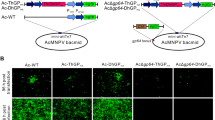Abstract
The recombinant baculoviruses were constructed to investigate the necessity of VSV-G pseudotyping for mammalian cell transduction. The viruses were designed to express green fluorescent protein (GFP) gene under the control of cytomegalovirus promoter, with or without pseudotyping with VSV-G. VSV-G was placed under the control of polyhedrin promoter that is recognized by insect cells, allowing the formation of pseudotyped baculovirus. The study findings demonstrate that the pseudotyping of baculovirus significantly enhanced transduction efficiency compared to non-pseudotyped baculovirus, resulting in consequent distinction in the expression of GFP in mammalian cells. The results confirmed that pseudotyping is important for baculovirus mediated gene delivery. Further, when full-length VSV-G pseudotyping was compared with truncated VSV-G containing GED domain (G-stem of ectodomain in conjunction with the TM and CT domains of the glycoprotein), latter was relatively less efficient in transducing mammalian cells. This study demonstrated that pseudotyping with full-length VSV-G had better transduction efficiency in mammalian cells. However, at higher multiplicity of infection, both full-length and truncated VSV-G showed equivalent transduction. This study established the significance of pseudotyping of baculovirus with full-length VSV-G for efficient transduction of mammalian cells, utilizing the highly sensitive GFP marker system. These findings have significant implications in designing of baculovirus vector based antigen delivery for developing new generation vaccines.



Similar content being viewed by others

References
Abe T, Matsuura Y. Host innate immune responses induced by baculovirus in mammals. Curr Gene Ther. 2010;10:226–31.
Basagoudanavar SH, Hosamani M, Tamil Selvan RP, Sreenivasa BP, Saravanan P, Chandrasekhar Sagar BK, Venkataramanan R. Development of a liquid-phase blocking ELISA based on foot-and-mouth disease virus empty capsid antigen for seromonitoring vaccinated animals. Arch Virol. 2013;158:993–1001.
Brusca J, Summers M, Couch J, Courtney L. Autographa californica nuclear polyhedrosis virus efficiently enters but does not replicate in poikilothermic vertebrate cells. Intervirology. 1986;26:207–22.
Cao Y, Lu Z, Sun P, Fu Y, Tian F, Hao X, Bao H, Liu X, Liu Z. A pseudotype baculovirus expressing the capsid protein of foot-and-mouth disease virus and a T-cell immunogen shows enhanced immunogenicity in mice. Virol J. 2011;8:77.
Carneiro FA, Stauffer F, Lima CS, Juliano MA, Juliano L, Da Poian AT. Membrane fusion induced by vesicular stomatitis virus depends on histidine protonation. J Biol Chem. 2003;278:13789–94.
Carneiro FA, Vandenbussche G, Juliano MA, Juliano L, Ruysschaert JM, Da Poian AT. Charged residues are involved in membrane fusion mediated by a hydrophilic peptide located in vesicular stomatitis virus G protein. Mol Membr Biol. 2006;23:396–406.
Finkelshtein D, Werman A, Novick D, Barak S, Rubinstein M. LDL receptor and its family members serve as the cellular receptors for vesicular stomatitis virus. Proc Natl Acad Sci USA. 2013;110:7306–11.
Grein TA, Michalsky R, Vega Lopez M, Czermak P. Purification of a recombinant baculovirus of Autographa californica M. nucleopolyhedrovirus by ion exchange membrane chromatography. J Virol Methods. 2012;183:117–24.
Huang H, Xiao S, Qin J, Jiang Y, Yang S, Li T, Gao Y, Li Z, Su X, Ruan Y, Xu F, Wang H, Chen H, Xia X. Construction and immunogenicity of a recombinant pseudotype baculovirus expressing the glycoprotein of rabies virus in mice. Arch Virol. 2011;156:753–8.
Jehle JA, Blissard GW, Bonning BC, Cory JS, Herniou EA, Rohrmann GF, Theilmann DA, Thiem SM, Vlak JM. On the classification and nomenclature of baculoviruses: a proposal for revision. Arch Virol. 2006;151:1257–66.
Kaikkonen MU, Raty JK, Airenne KJ, Wirth T, Heikura T, Yla-Herttuala S. Truncated vesicular stomatitis virus G protein improves baculovirus transduction efficiency in vitro and in vivo. Gene Ther. 2006;13:304–12.
Mangor JT, Monsma SA, Johnson MC, Blissard GW. A GP64-null baculovirus pseudotyped with vesicular stomatitis virus G protein. J Virol. 2001;75:2544–56.
Roche S, Rey FA, Gaudin Y, Bressanelli S. Structure of the prefusion form of the vesicular stomatitis virus glycoprotein G. Science. 2007;315:843–8.
Sarkis C, Serguera C, Petres S, Buchet D, Ridet JL, Edelman L, Mallet J. Efficient transduction of neural cells in vitro and in vivo by a baculovirus-derived vector. Proc Natl Acad Sci USA. 2000;97:14638–43.
Schauber CA, Tuerk MJ, Pacheco CD, Escarpe PA, Veres G. Lentiviral vectors pseudotyped with baculovirus gp64 efficiently transduce mouse cells in vivo and show tropism restriction against hematopoietic cell types in vitro. Gene Ther. 2004;11:266–75.
Sun X, Belouzard S, Whittaker GR. Molecular architecture of the bipartite fusion loops of vesicular stomatitis virus glycoprotein G, a class III viral fusion protein. J Biol Chem. 2008;283:6418–27.
Suzuki T, Chang MO, Kitajima M, Takaku H. Baculovirus activates murine dendritic cells and induces non-specific NK cell and T cell immune responses. Cell Immunol. 2010;262:35–43.
Tani H, Nishijima M, Ushijima H, Miyamura T, Matsuura Y. Characterization of cell-surface determinants important for baculovirus infection. Virology. 2001;279:343–53.
Wang S, Fang L, Fan H, Jiang Y, Pan Y, Luo R, Zhao Q, Chen H, Xiao S. Construction and immunogenicity of pseudotype baculovirus expressing GP5 and M protein of porcine reproductive and respiratory syndrome virus. Vaccine. 2007;25:8220–7.
Wu C, Wang S. A pH-sensitive heparin-binding sequence from Baculovirus gp64 protein is important for binding to mammalian cells but not to Sf9 insect cells. J Virol. 2011;86:484–91.
Acknowledgments
The authors thank the Director, ICAR-Indian Veterinary Research Institute (IVRI), Izatnagar and Joint Director of IVRI Bangalore, for facilitating this work. SMK acknowledges JRF received from Indian Council of Agricultural Research. Authors also thank Dr. B.P. Sreenivasa for useful discussion.
Author information
Authors and Affiliations
Corresponding author
Rights and permissions
About this article
Cite this article
Kolangath, S.M., Basagoudanavar, S.H., Hosamani, M. et al. Baculovirus mediated transduction: analysis of vesicular stomatitis virus glycoprotein pseudotyping. VirusDis. 25, 441–446 (2014). https://doi.org/10.1007/s13337-014-0229-5
Received:
Accepted:
Published:
Issue Date:
DOI: https://doi.org/10.1007/s13337-014-0229-5



